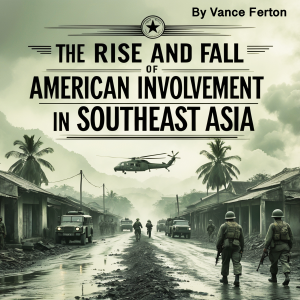

The Rise and Fall of American Involvement in Southeast Asia
Vance Ferton
This audiobook is narrated by a digital voice.
The roots of American involvement in Southeast Asia extended far deeper than the dramatic escalation of the 1960s, tracing back to the fundamental shifts in global power dynamics that emerged from World War II and the subsequent collapse of European colonial empires. The United States found itself thrust into a position of global leadership at precisely the moment when traditional imperial powers were losing their grip on vast territories that had been under foreign control for centuries. This confluence of American ascendancy and European decline created both opportunities and obligations that would ultimately draw the United States into one of its longest and most costly foreign interventions.
The initial American engagement with Southeast Asia during World War II had been primarily military and strategic, focused on defeating Japanese forces and restoring stability to a region that had been devastated by years of occupation and warfare. However, the wartime experience also exposed American officials to the complex political dynamics that characterized the region, particularly the growing strength of nationalist movements that sought independence from European colonial rule. These movements presented American policymakers with difficult choices between supporting traditional allies and embracing the principle of self-determination that had long been a cornerstone of American political philosophy.
Duration - 56m.
Author - Vance Ferton.
Narrator - Digital Voice Matt G.
Published Date - Monday, 20 January 2025.
Copyright - © 2025 Vance Ferton ©.
Location:
United States
Description:
This audiobook is narrated by a digital voice. The roots of American involvement in Southeast Asia extended far deeper than the dramatic escalation of the 1960s, tracing back to the fundamental shifts in global power dynamics that emerged from World War II and the subsequent collapse of European colonial empires. The United States found itself thrust into a position of global leadership at precisely the moment when traditional imperial powers were losing their grip on vast territories that had been under foreign control for centuries. This confluence of American ascendancy and European decline created both opportunities and obligations that would ultimately draw the United States into one of its longest and most costly foreign interventions. The initial American engagement with Southeast Asia during World War II had been primarily military and strategic, focused on defeating Japanese forces and restoring stability to a region that had been devastated by years of occupation and warfare. However, the wartime experience also exposed American officials to the complex political dynamics that characterized the region, particularly the growing strength of nationalist movements that sought independence from European colonial rule. These movements presented American policymakers with difficult choices between supporting traditional allies and embracing the principle of self-determination that had long been a cornerstone of American political philosophy. Duration - 56m. Author - Vance Ferton. Narrator - Digital Voice Matt G. Published Date - Monday, 20 January 2025. Copyright - © 2025 Vance Ferton ©.
Language:
English
Chapter 1: The Seeds of Involvement
Duration:00:10:03
Chapter 2: The Kennedy Years and Deepening Commitment
Duration:00:10:51
Chapter 3: Johnson's War and the Escalation to Full Combat
Duration:00:11:20
Chapter 4: Nixon, Vietnamization, and the Long Withdrawal
Duration:00:12:16
Chapter 5: Aftermath and Historical Legacy
Duration:00:11:54